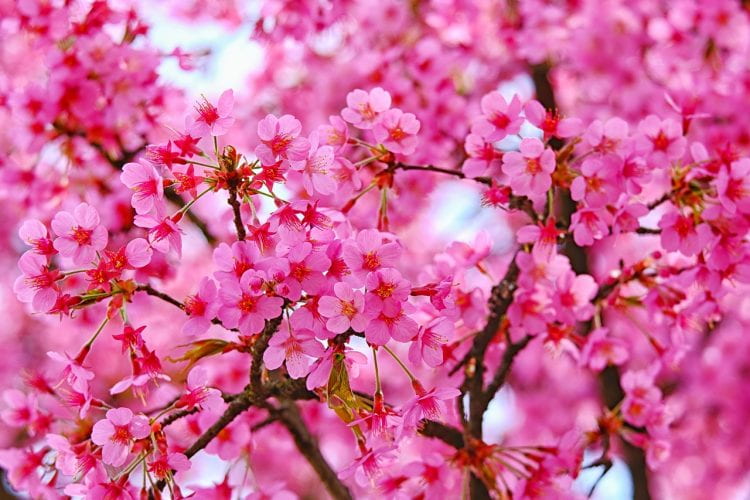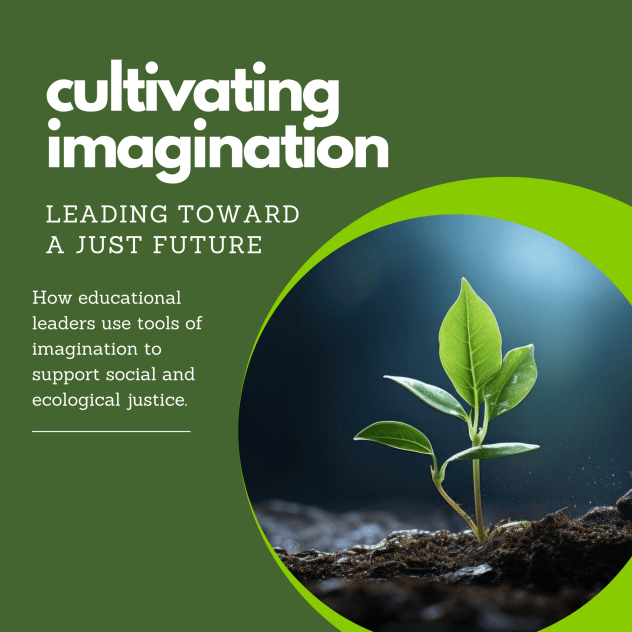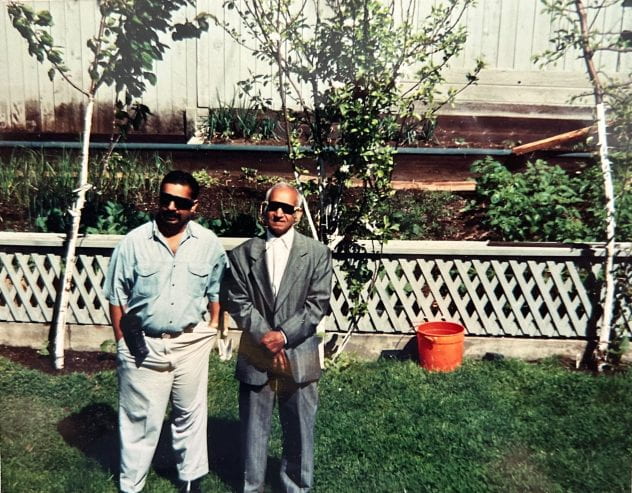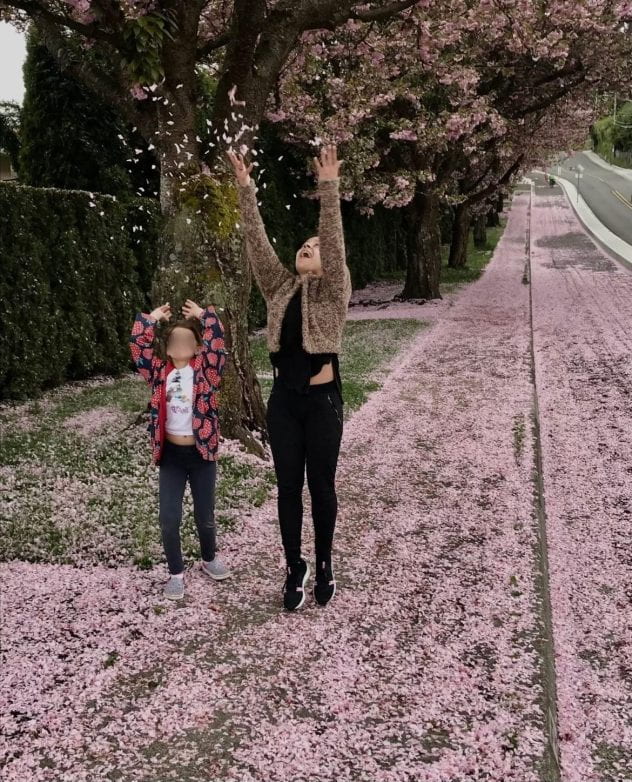by Sandeep Kaur Glover, Faculty of Education at Simon Fraser University
Note: This blog is an extension of the Episode 8 Cultivating Imagination podcast.
Since my invigorating podcast interview with Heidi Wood, I have been ruminating on the nourishing resonances of our conversation. As I pondered what to share with you for this blog, I did not start by clicking characters on my keyboard. I’ve learned that when I start any inquiry in stationary pose, I soon find myself stuck in siloed theorizations, whether it is one disciplinary approach, one metanarrative, or one philosophical concept.
Like my ancestors, I need to move to learn, and this is when learning moves me. As an embodied researcher, I dance with the fierce love of ancestral agency. I walk amid Earth’s choruses to imbibe the goosebump imbued wonder that abounds. I listen to and from the knowledge in my body like the subtle shifts of my breath that allow me to articulate from a place of authenticity.
And as I type these words, I’m aware that the notion of embodied knowing will probably sound strange to you. This is no coincidence. The body has most often been absent and sidelined in education amid philosophical legacies that separate the mind from the body. With this legacy, the so-called mechanical body is deemed a thing and often pedagogically employed as ‘brain breaks’ to service the superior brain where the ‘real’ business of learning takes place. But bodily intelligence, although we don’t usually name it as such, is something we engage with all the time, especially in the context of imagination. Even Albert Einstein, who is indubitably a paragon of cerebral genius, reveals in his autobiography how physical sensations such as vibrations and tingles informed his imagination and led to some of his most important discoveries.
Through my research journey that brings to the fore the body and its capacities for imagination, I have been inhabiting stories that arise through my senses, what I have conceptualized in my research as sensorial snapshots, in revisiting and rediscovering Punjabi-Sikh knowledges and ancestral wisdom. Today, as I went for a sunny Spring walk and surrendered to the soft embrace of cherry blossoms, I imaginatively found myself in the backyard of my childhood home among the cherry trees that my Babaji (grandfather) had planted. And as I continued to walk between present and past worlds, I viscerally recall walking home from junior high school while listening to the radio station LG73 on my Sony Walkman when I was stunned to hear the radio host share some breaking news about my Babaji. The host stated that an elderly South Asian man in a dark blue plaid jacket was hauling three young cherry trees across the Trans-Canada Highway and causing major traffic disruptions.
When I heard the breaking news, I knew that the radio host was speaking about my Babaji because he had taken my favorite blue plaid jacket on way too many occasions. And so, the first thought that entered my teenage mind-heart was, “What if my friends see my grandfather wearing my favorite plaid jacket?!” But this worry dissolved when I arrived home to face three young cherry trees in our yard. Eyes widened in bewilderment, I asked Babaji why he had uprooted these trees without permission. Completely composed in his response, he uttered, “The trees wanted to be moved.” I inquired further and Babaji told me that the trees had been flagged for destruction due to an imminent new build, and so, he had no choice but to help his friends survive.
As a teenager, I felt a deep sense of shame for Babaji’s unruliness, especially since his ways of relating to the world differed from much of my formal schooling that had been steeped in colonial logics of separation, individualization, and domination. But now, decades later, when I walk by these cherry trees that stand with such lofty dignity, just like my late Babaji’s resolute stance that stopped traffic, I finally fathom how Babaji’s imagination was not at all flawed, but fiercely rooted in Sikh principles of love, humility, interconnectedness, and justice. My Punjabi-Sikh ancestors’ imagination started with a lower case “i”, that is, the embedded “i” that humbly exists because of different characters. The “i” that sits alongside one another in the awareness of interconnectedness.
Through my embodied research journey, I have been tracing the veins of my family’s stories of joy, beauty, shame, and resiliency across five generations, all remarkably within one Greater Vancouver suburb. My ancestors were among the first Punjabi-Sikh migrants to settle on Coast Salish land in the early 1900s. Across the generations, my family’s lived experiences have taken place in the same schools, hospitals, and communities. Amid the wonder and joy of these relational experiences, there too exists the excruciating pain of institutional classism, racism, and sexism. Across the interstitial tissues of my family’s generational experiences, it is evident that colonial violence persists in our institutions and continues to inflict generational and cumulative harm in the form of trauma, illness, and the denial of dignity.
Because many of our institutions were first imagined and constructed based on the capital and hierarchical “I” of Imagination, where the first letter stands taller than the Other in elevated stature from its perched vantage point at the smaller characters, these structures implicitly reinscribe fear, control, power, and individualism. But because such societal structures of separation and individualization have been normalized, as Dr. Gabor Maté shares, toxicity blurs into the background of our day-to-day business.
If educational leaders seek to address structural inequities, then first, it seems that we require a nuanced understanding of how oppression looks, feels, sounds, and shapeshifts. And if systems of oppression like racism are visceral experiences that land with great violence on bodies, as Ta–Nehisi Coates shares, and if the body, too, is a primary site for the metabolization of pain and trauma, as Resmaa Menakem shares, I believe that healing and reimagining start with the awareness of the truths that arise through our bodies where our herstories are stored and may be storied.
Following in the spirit of the late, great, bell hooks, an important starting point for educational leaders could be to take a sober look within their own organizations to confront the pain that has been historically inflicted on those in the margins in seeking change. I realize that this reflective work is unsettling, but meaningful dialogue invariably begins with difficult questions like, “How is our system complicit in perpetuating systems of oppression and intergenerational trauma? And, in taking accountability for systemic harm, what tangible steps can we take to support personal and communal healing as we radically reimagine and enact policies and practices that are ethical and equitable?” I agree with Dr. Jody Carrington when she spoke to first responders in February of 2023 about how workplace stress is at all time high because organizational structures were built on archaic rules that no longer serve us.
Too many of my family members have been pushed out of school following traumatic incidents of racism and sexism that remain hidden due to institutional silencing. How is it that my daughter was asked by her teacher to clean up another student’s “explosive” nose bleed with her bare hands and paper towel and was criticized in front of her peers for not properly cleaning the blood that had begun to dry in the same organization, at the same school, on the same floor, and in the same grade as when I was asked by my teacher to clean up a pool of another student’s urine with my bare hands and paper towel while I felt the weight of my white peers’ gaze?
Not only did the organization not follow its own policies on health and safety and student care and well-being, but there were zero opportunities to reimagine ethical practice in the face of denial and defensiveness. Although teaching and community-building had been some of my greatest joys as a long-time educator in the same institution I attended as a student, the cumulative heaviness of its doors told me that I did not belong. And to be clear, it was not the glaring repetition of the story that led me to resign from my teaching position, for I held on to hope for humanizing dialogue, but rather, the organization’s hierarchical processes of silencing, exhaustion, dehumanization, and re-traumatization.
Institutional oppression deprives people of their birthright to dignity, when dignity, I believe, is the birthplace of imagination. Institutional oppression perpetuates intergenerational trauma and can lead to PTSD and chronic health issues as trauma-informed studies inform. And this violence does not just impact one individual, it devastates students, families, and communities, and in particular communities that have historically been marginalized. Although the pain can be debilitating, I’ve learned that it also contains vital information that enables us to imagine differently and directly from the cracks in our systems and the crankiness in our cranial bones.
As the TRC: Calls to Action illuminates, moving forward with courage commences with the acknowledgement of truth, for truth is essential to (intergenerational) healing, reconciliation, and dignity, our human rights. Through embodied research, I’ve come to understand how the truths that surface from my storied body hold transformative possibilities for healing and justice.
I draw from Dr. Maxine Greene who highlights how the arts crack open avenues for imagining that may awaken us to what has been ordinarily unseen, unheard, and unexpected. As such, I offer a creative-critical poem that draws from the repetitive pulsations of my embodied institutional experiences, of racialized women’s experiences in educational settings found in Drs. Sara Ahmed and Rita Kohli’s research, and of my ongoing reflections in working alongside racialized educators, researchers, and leaders across B.C. With a sense of care and caution, I invite you into this space of imagination that is inevitably uncomfortable for anti-oppressive explorations that include sensitive content. Because the sensorial is structural, these shared stories are not private, but belong in public realms where they can be acknowledged, so that (re)humanization, healing, and reimagination may take flight.
And so, I invite you to reflect on one extended workplace scenario that includes a succession of imaginal shards. What would happen to your sense of beingness if you were excited to have just been hired into a new position alongside multiple older white women and you find yourself:
being told at your first formal meeting with a new colleague
who is higher up the educational hierarchy
that you will not last on the job
essential work-related resources being withheld from you
being excluded from meetings that are required for your position
being told you are too passionate, too sensitive, too warm and fuzzy
being spat on with aggressive insults delivered inches from your nose
doors being slammed in your face
being told that the problem is merely a personality clash
being acutely aware of the clickety-clacking of heels
so you can f-i-n-a-l-l-y hustle after her to provide crucial student updates
while she walks right past you to solidify your invisibility
being threatened with a performance evaluation
being nauseous to the point of vomiting each day
being terrorized by nightmares
being encouraged to take a medical leave
as your colleagues witness your withering health
while leaders avoid addressing the mounting toxicity
being told that you will not receive an apology
for the mistaken release of confidential documents
that contain your private thoughts, feelings, and medical details
and consequently,
being aware that an impartial investigation
is no longer possible
and instead of an apology for the leaky error,
you are being offered additional sick days
if you drop your complaint in suffocating silence
being unable to parent your young children for almost a year
being forced out of your beloved workplace community
where you have invested your heart, mind, body, and spirit
for almost a decade
to be sexually harassed on the first day at your new school
when an older white male locks eyes with you
while mimicking motions of masturbation
as you struggle to locate a photocopier
being stuck in spirals of smallness
and trauma-induced sickness
while perpetrators of institutional violence
are being given the green light
to continue climbing institutional rungs
without being held accountable
because their bodies hold greater worth
in a colonial-infused hierarchy
that rarely uses terms like racism and sexism
I realize that the poem may have created tension in your body, or perhaps it did not surprise you. Amid the heavy backdrop of historical ghosts, what gives me hope is the potency of truth. Since trauma proliferates in shades of invisibility and invalidation, communal spaces that support truth-telling may provide healing balm for the embodied pain of oppression, while the specificities of these truths may catalyze our collective imagining for equitable futurities. In Sikhi, truth grows out of one sacred, primal Punjabi phrase, Ikk Oan Kar, which illuminates our inextricable interconnectedness and multifarious oneness, and the dignity that every body, human and the more-than-human, inherently possesses.
And like the ontological truth of our oneness, I believe that social and ecological change starts with one awakening breath, one resolute knowing, and one act of resistance, as we wake up to our fulsome selves, our hearts, minds, bodies, and spirits, and to the innate dignity of one another. I sometimes imagine what a difference it would have made to me and my family if just one educational leader had stood alongside me and validated my experience and sense of dignity during moments of utter despair.
As Dr. Ruha Benjamin mentions, so much injustice happens when we passively clock in and out of work in disembodied ways and follow the default imprints of the past. Even though we have normalized and rationalized hierarchical and individualistic dynamics, it is clear that our collective health and well-being are deteriorating. That is because our bodies know what our minds may not, as Dr. Snowber shares. Perhaps liberation is not a cerebral reaching, but an embodied surrendering where we may meet through the rhythms of our sensorial cues with curiosity as we attune to what is, and to what may become. Like my ancestors, why are we not breathing together, poeticizing together, dancing together, and witnessing one another’s embodied truths together in radically reimagining and enacting a just world?
I hang on to the seed of my ancestors’ imagination for an equitable world, just as I hang on to the hope that is generated through bold conversations in Cultivating Imagination. And to my guest reader, thank you deeply for walking with me and I hope we have the chance to continue this conversation.
I am concluding my blog journey with the beloved Richard Wagamese’s wise words from his book, Embers: One Ojibway’s Meditations (p. 44):
From our very first breath, we are in relationship. With that indrawn draft of air, we become joined to everything that ever was, is and ever will be. When we exhale, we forge that relationship by virtue of the act of living. Our breath comingles with all breath, and we are a part of everything.
Ahmed, S. (2021). Complaint!. In Complaint!. Duke University Press.
Benjamin, R. (2024). Imagination: A Manifesto. WW Norton.
Glover, S. K. (2024). Fleshing Out the Embodied Potentialities of Positionality. Qualitative Inquiry, 30(2), 154-162.
Greene, M. (2000). Releasing the imagination: Essays on education, the arts, and social change. John Wiley & Sons.
Kohli, R. (2021). Teachers of color: Resisting racism and reclaiming education. Cambridge, MA: Harvard Education Press.
Maté, G. (2022). The myth of normal: Trauma, illness and healing in a toxic culture. Knopf Canada.
Menakem, R. (2017). My Grandmother’s Hands: Racialized Trauma and the Pathway to Mending Our Hearts and Bodies. Central Recovery Press.
Singh, N.-G. K. (2019). First Sikh. India Viking.
Snowber, C. (2018). Living, moving, and dancing. Handbook of arts-based research, 247-262.
S5E06—”An Approach of Care, Healing & Dignity” with Meena Mangat. Spreaker. Retrieved April 3, 2024, from https://www.spreaker.com/episode/s5e06-an-approach-of-care-healing-dignity-with-meena-mangat–51640234
Hear more from our leaders in the Cultivating Imagination podcast series.





